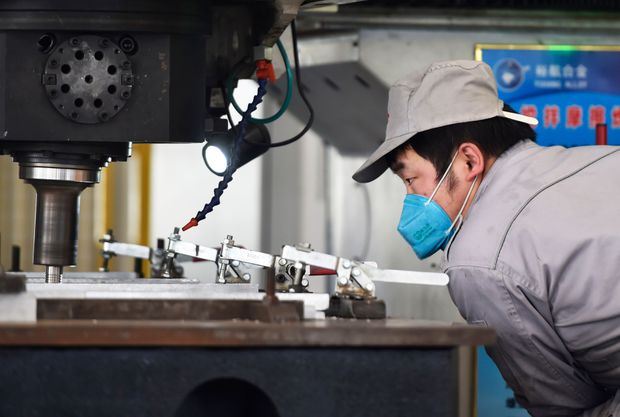China has released a reckoning of the economic destruction inflicted by the deadly novel coronavirus – a tally of losses that stands as a grim omen for other countries now struggling to contain the pandemic.
In the country’s first statistical report card of the year, the Chinese data marks “the sharpest fall in almost 50 years” for what is now the world’s second-largest economy, Macquarie economist Larry Hu noted Monday.
Fixed asset investment for January and February dropped 24.5 per cent from the same period last year. Industrial production was down 13.5 per cent, with automotive output tumbling 46 per cent. Retail sales fell 20.5 per cent, property sales 40 per cent and new property starts were down 45 per cent. Exports contracted 15.9 per cent. Some five million jobs have been lost, with unemployment rising from 5.3 per cent to 6.2 per cent.
It all amounts to “horrendous data,” economists at Société Générale wrote Monday, saying negative first-quarter GDP growth is now “almost certain.”
Panic once against hit stock markets Monday. The Shenzhen Stock Exchange Composite Index shed almost 5 per cent in value. Shanghai fell almost 3.5 per cent. Australia’s S&P/ASX 200 had its worst day since 1987, plunging 9.7 per cent.
What has happened in China should serve as “a lesson to other countries: when the nest is upset, no egg is left intact,” said Xu Yang, managing director of Shanghai Macro Information Consulting Co., Ltd. “The rest of the world should know that, even though China has taken such strong preventative measures and undergone so much preparation, the hit to our economy is still considerable in scale – let alone what will happen to other countries.”
And while China’s leaders have urged the resumption of work across the country, the implementation of virus-related shutdown measures around the world could portend much longer-term damage, both inside and outside China.
“China could slow much more in the event of extended disruptions to the global economy – and even a second outbreak of COVID-19 later in the year,” said Darren Tay, senior country risk analyst at Fitch Solutions. For China, growth could drop as low as 2 per cent this year. Fitch has forecast a contraction of more than 2 per cent in Italy. “France and Germany are also looking increasingly vulnerable,” Mr. Tay said.
The revelation of the immensity of economic reversal in China – a country whose leaders have admitted to statistical manipulation in the past – suggests a desire by Beijing to send a message, said Alicia Garcia-Herrero, chief economist for Asia Pacific at Natixis, a French corporate and investment bank.
“China is trying to scare the world,” she said. By describing the great cost of the virus in stark numbers, Beijing is telling other countries, “Do everything you can for your own sake” to combat the virus and limit its economic impact, Ms. Garcia-Herrero said. Such a warning will also benefit China, whose own recovery will depend in part on what happens outside its borders.
STORY CONTINUES BELOW ADVERTISEMENT
“What China hopes and needs is for the situation in other countries to improve because they are our important trade partners” said Mei Xinyu, a researcher with the Chinese Academy of International Trade and Economic Cooperation, a research body under the Ministry of Commerce. “Only if they get back to normal can we resume our exports and sales.”
Publishing disturbing numbers can also have domestic value, said Wang Zhenzhong, an economic researcher at the Chinese Academy of Social Sciences. “Government is trying to stimulate domestic industries to speed up production and boost the economy in the second quarter. Showing people how much we’ve lost will help motivate them to produce more,” he said. Annual growth of 5.5 per cent in 2020 remains possible for China, he said.
Chinese leaders have so far refrained from repeating the heavy-spending rescue effort they mounted after the great financial crisis in 2008. China has eased its bank reserve requirement ratios sufficiently to allow an additional $110-billion in liquidity, but Chinese Premier Li Keqiang has downplayed the country’s economic growth targets for this year. China left interest rates on medium-term loans untouched Monday, bucking a trend of cuts by other central banks – most significantly the U.S. Federal Reserve, which cut rates to zero. In a commentary published Monday, the National Bureau of Statistics said more than 85 per cent of medium-sized manufacturing enterprises have returned to work, calling the epidemic “basically curbed.”
“The impact of the epidemic is short-term, external and controllable,” the bureau wrote, stressing the long-term economic fundamentals of the economy.
“The second quarter is going to see a significant rebound from the first quarter,” bureau spokesman Mao Shengyong said in comments following the data release. “As the policy effects become more visible, with more potent measures in the next step to counter the shock, we expect that the economy will be more sound in the second half of the year.”
But others saw little reason for optimism.
“It’s worth noticing that these numbers only showed the impact the domestic virus situation has brought to our economic performance. The second round of shocks created by the global epidemic haven’t yet fully appeared,” Mr. Xu said. “If the rest of the world sees a decrease in their economic development due to the influence of the virus, we won’t see life becoming easy.”
With reporting by Alexandra Li





















